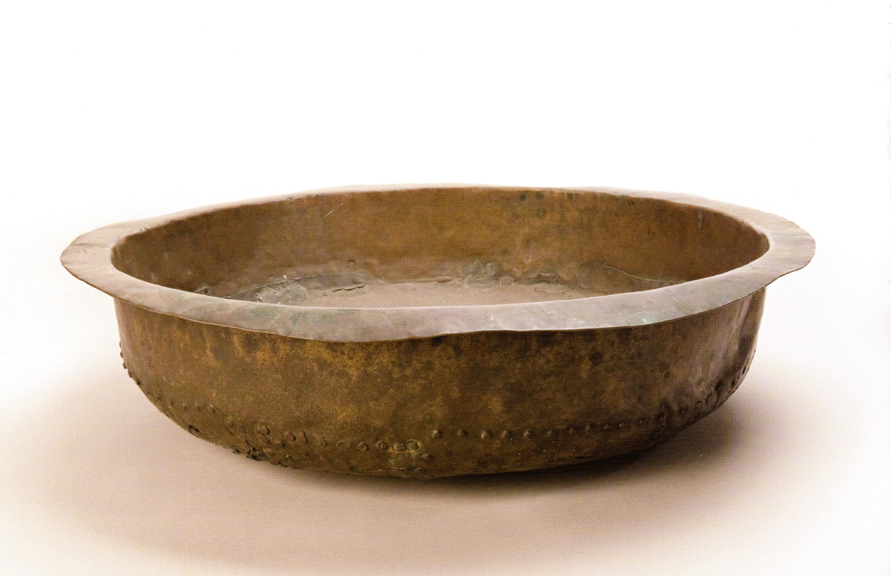Dorchest
We are continuing to share the Society’s collections by email and through other online methods.
Today’s illustration features a bowl brought to America by the Capen family who migrated in the 1630s. Barnard [or Bernard] Capen, a shoemaker, and his wife Joan Purchase Capen arrived in Dorchester in 1633 on an unnamed ship with sons Bernard and John, and daughter Honor. Earlier their two daughters had come to Dorchester: Susanna with her husband William Rockwell and Dorothy with her husband Nicholas Upsall who came in 1630 on the ship “Mary and John”. The Capen family brought with them this hammered brass bowl, probably made in Spain in the late 16th century.
Possibly of Spanish origin, the Capen Bowl is about 20 inches in diameter and 5 inches deep. The size of the bowl required it to be made of several sheets of metal riveted together. It was probably used for every purpose a bowl could be used for, from washing dishes to washing a baby. The bowl was exhibited in 1982 at the Museum of Fine Arts, Boston, in the exhibit New England Begins.
Built by 1637, the Barnard Capen House was located at corner of what is now Washington and Dunlap Streets. The house is considered to be the second oldest house in New England and was built in the style of the West Country with heavy framing. “The farthest end of the house, consisting of four or five rooms, was built first; and some hundred years later the end nearest the street was added. The house was built on one side with especial reference to protection from the Indians; and the present owner [John Hewins] has found several arrows,during his residence there, which had been sent with hostile intention by the wily savages against the home-fortress of his ancestors.” — William Dana Orcutt. Good Old Dorchester. (Cambridge, 1893) 357. In 1833 a Capen relative, John Hewins, bought the house and built additions and a shed.
The house that Barnard and Joan built in the 1630s remained in the Capen family for nearly 270 years. In 1909 it was taken apart and moved and reassembled at 427 Hillside Street in Milton near Houghton s Pond where it remained until the early 20th. century. The Boston Sunday Herald, Feb. 7, 1909, carried an article entitled “Barnard Capen’s Old Home in Peril” that stated that the contractor who was about to demolish the house to make way for a development of three-deckers would gladly spare the old house if some society or public-spirited citizen desired its preservation.
Harvard Professor, Kenneth Grant Tremayne Webster, bought the house for $50. “Through a relative, Webster engaged an MIT student to make drawings, number, codify and catalogue every board, brick and timber in the old house. He next hired a building wrecker to take the house apart and haul its components to a plot he owned at 427 Hillside Street, Milton. A carpenter then put the house back together.”–Milton Times
When a new owner wanted to replace the house with a larger and more up-to-date design, the Capen House was again taken apart and put in storage for possible sale to a new owner.
Barnard and Joan’s gravestone in the Dorchester North Burying Ground is said to have the oldest date of any known gravestone in New England. The stone was moved to the New England Historic Genealogical Society. Barnard lived from approximately 1562 to 1638 and Joan from 1578 to 1653. In December, 2015, David Allen Lambert blogged about the stone’s fragments for the New England Historic Genealocial Society, stating that it is likely, the stone was carved in the 1670s and replaced a wooden grave marker.
https://vitabrevis.americanancestors.org/2015/12/a-grave-concern/

